
As far as garden vegetables go, zucchini are pretty tough plants. They’re naturally drought tolerant, will grow in all kinds of soil and will continue to provide you with summer squash even when nibbled on by the odd pest here and there.
But when things start to take a turn, the leaves are usually the first place we notice signs of trouble. Learning to diagnose common zucchini and summer squash issues by what’s going on with the leaves can help get your plant back on the right track.
Leaves are a Great Litmus Test for Plant Health
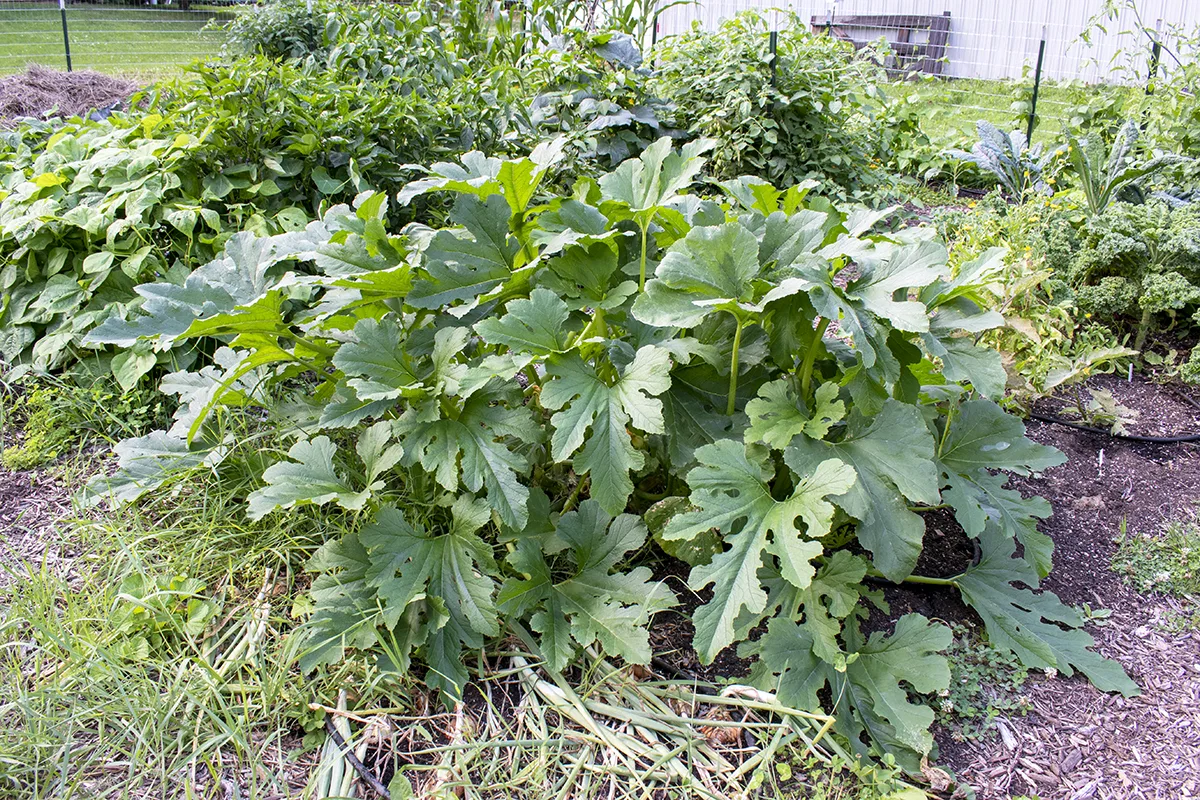
Because zucchini and other summer squash grow large, leafy canopies to shield the fruit and vines growing below them, the appearance of the leaves can be a good guide to plant health. After all, you can tell, at a glance, if things are doing okay.
A healthy zucchini plant should have large leaves, emerald green in color. The leaves should be sturdy and hold their shape. Some varieties may have variegated leaves, so take note when reading the seed packet.
As the season progresses, the canopy will grow quite large unless you prune or stake your zucchini. Familiarizing yourself with how common pests and diseases affect the plant’s leaves can make it much easier to spot issues at a glance and deal with them promptly.
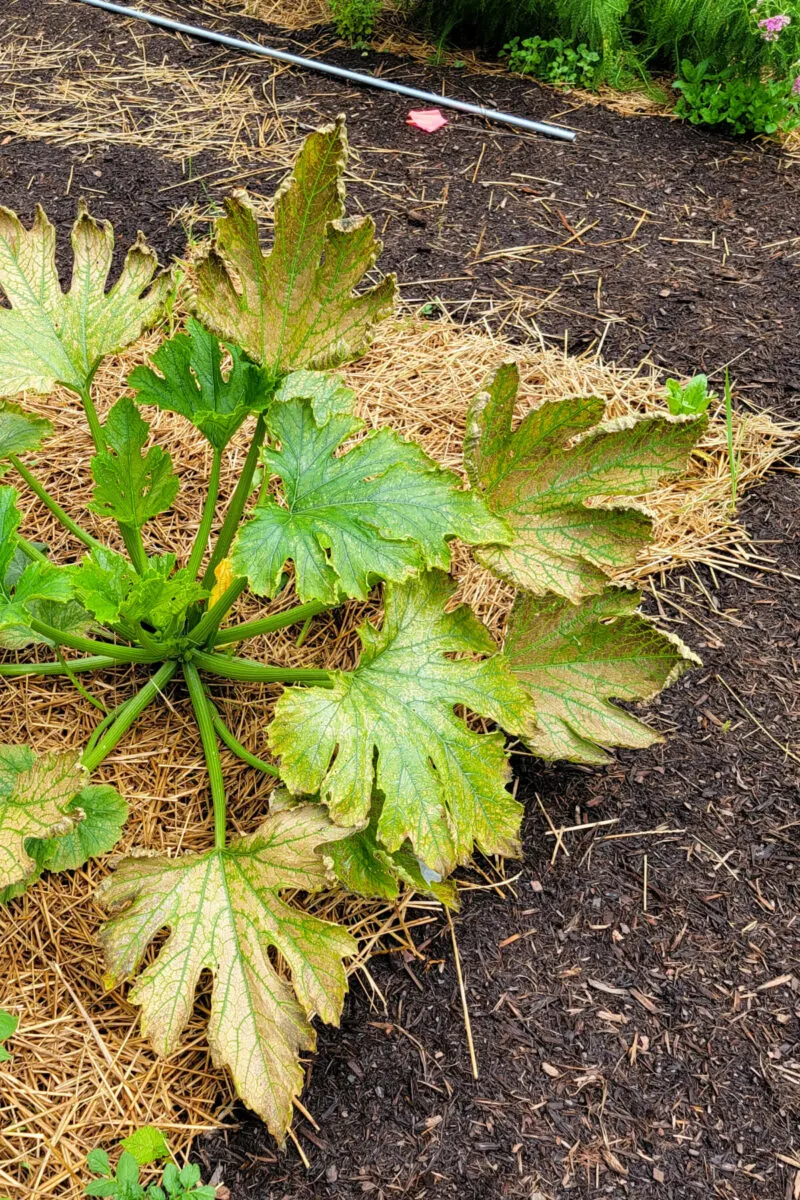
1. Wilting Leaves
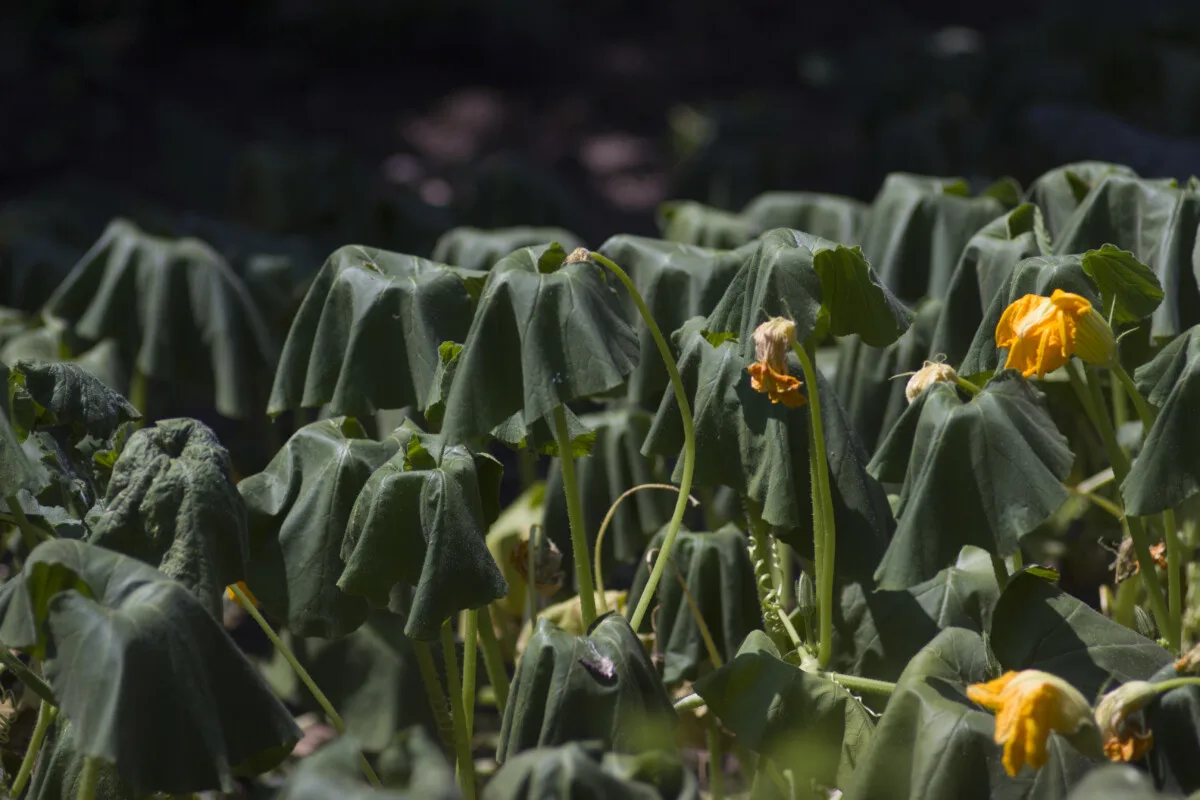
Water Issues
Droopy or wilting leaves that otherwise appear normal in color seem pretty obvious – clearly, your plant needs to be watered, right? Possibly, but that’s not always the case.
If the plant is otherwise healthy and you haven’t had rain for a bit, it’s most likely the plant needs to be watered. That one is easy to diagnose and fix.
But there are several other issues which can cause wilting leaves.
Oddly enough, too much water can cause drooping leaves as well. If the ground is waterlogged from too much rain, it can cause the roots to rot or become impacted by heavy, wet soil. The leaves will droop as a result, as they aren’t receiving water and nutrients from the roots despite there being plenty of water in the soil.
Compacted Soil
Similarly, compacted soil will also cause root issues, depriving the leaves of water and nutrients. If you have heavy clay soil or grow zucchini in an area of your garden with heavy foot traffic, the soil can become compacted, compressing and damaging the roots.
Squash Vine Borer
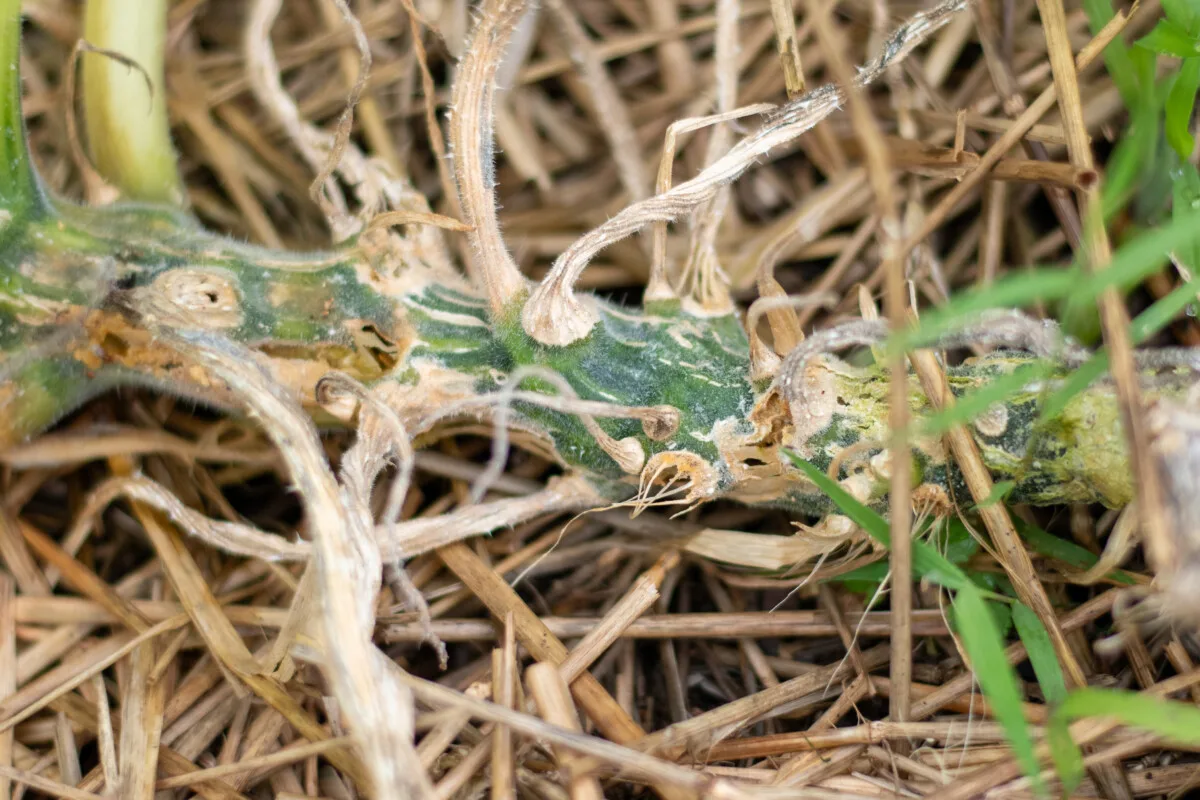
Wilting leaves can also be one of the first signs of squash vine borer, as they bore into the plant’s vascular system, disrupting the flow of nutrients and water. If you suspect squash vine borers, inspect the plant stem close to where it comes out of the ground. Look for open lesions or spots anywhere on the stem where it looks as if fine sawdust is coming out of the stem. You can learn how to control squash vine borer here.
Bacterial Wilt
Bacterial wilt (Erwinia tracheiphila) will also cause vascular issues in a plant and lead to wilting leaves; however, you’re more likely to notice this earlier in the season, just as the plant begins developing vines. A good clue is to check when plants are at their perkiest first thing in the morning. If your zucchini is wilting, then chances are good it’s bacterial wilt.
Along with wilting leaves, you’ll notice discolored stems and much darker than normal green leaves. Unfortunately, once a plant is infected, you will need to remove and destroy the plant to prevent it from spreading. (Burning the plant is best if you are able.) Rotating crops annually can help prevent recurring diseases like this one.
Nutrient Deficiency
Finally, and much less common, wilting can be caused by a potassium deficiency in your soil. We always recommend having your soil professionally tested to determine deficiencies before adding amendments. Lindsay has a thorough article about common soil deficiencies and how to diagnose them.
2. Leaves with White Patches
Variegated Leaves
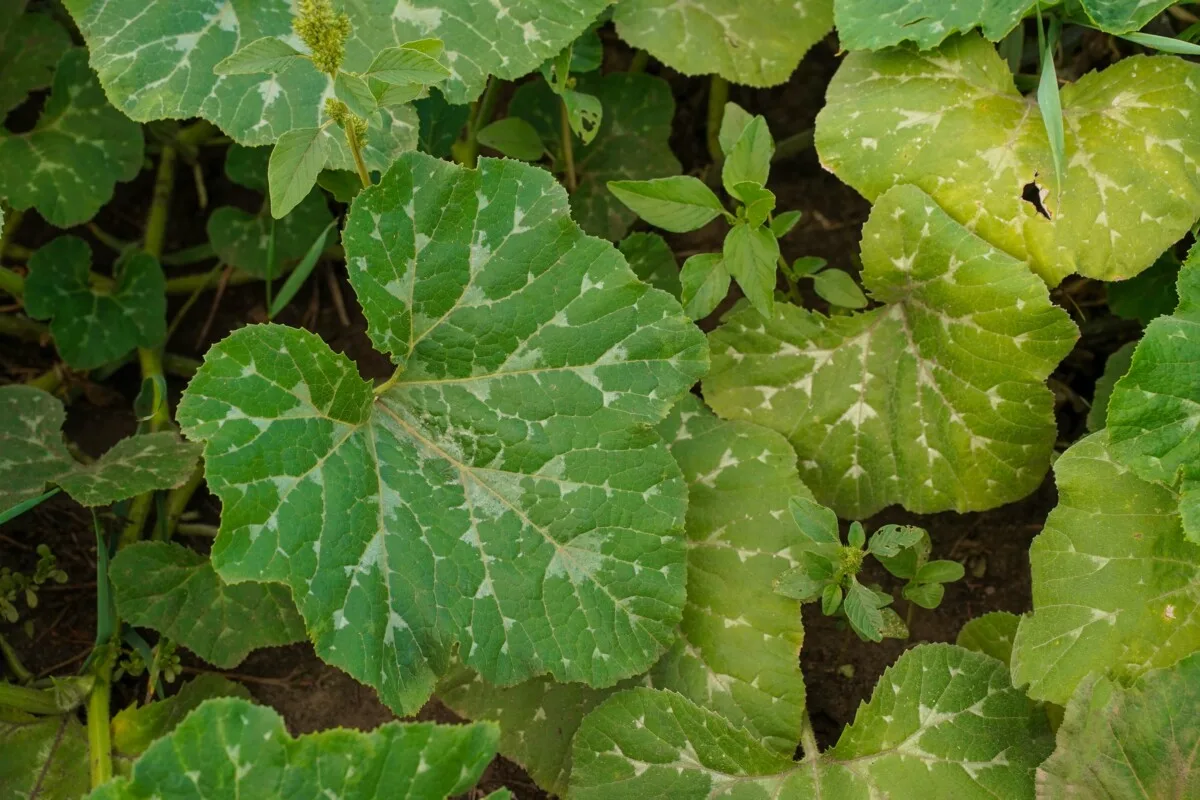
Remember, some zucchini varieties will have naturally variegated leaves.
Powdery Mildew
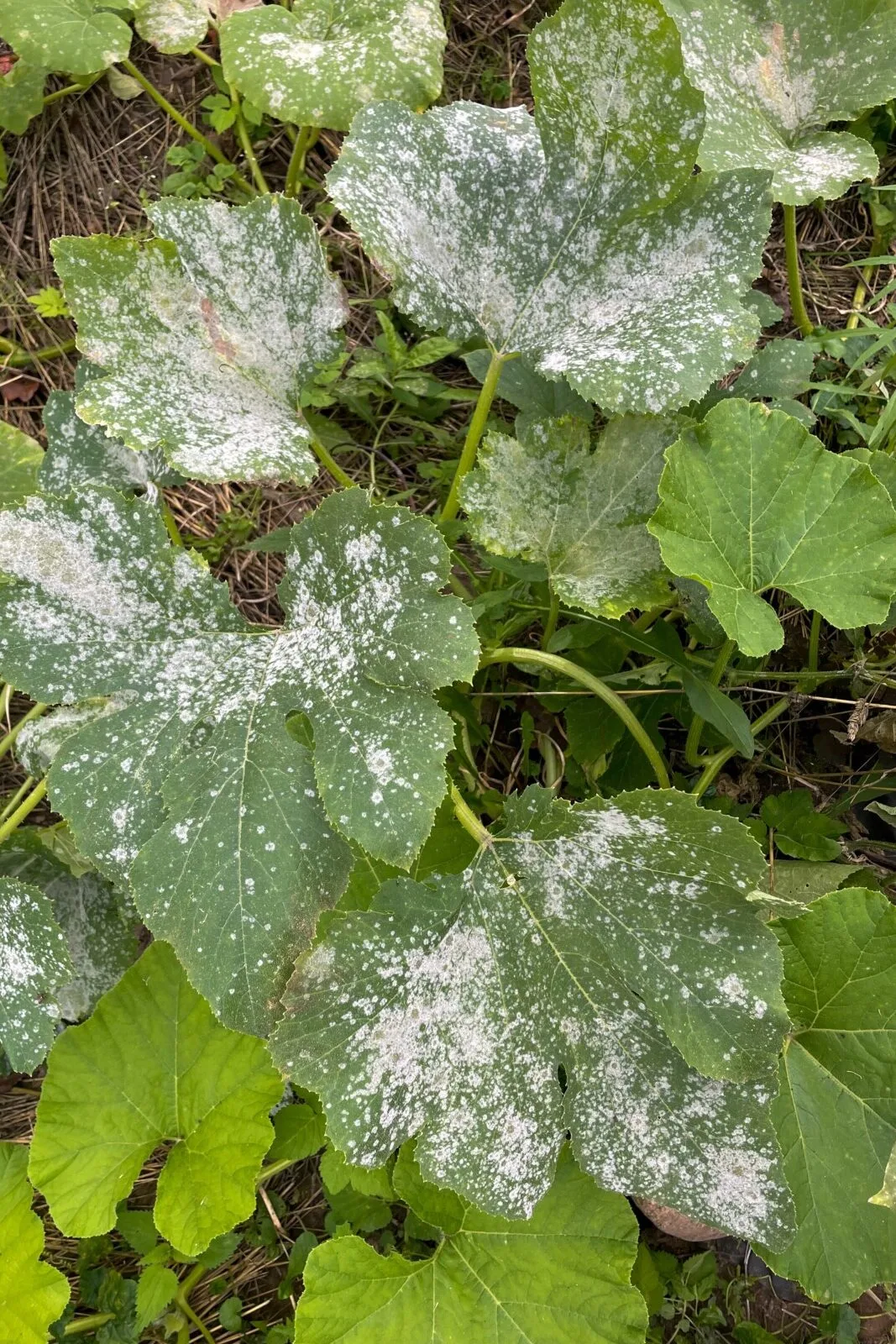
The most common reason for white patches on plants is powdery mildew. Powdery mildew is one of the most common fungal diseases affecting plants worldwide. Because so many plants can contract it, it spreads quite rapidly. Chances are, if one plant in your yard or garden has it, it will eventually make its way to your zucchini.
It presents as small patches on the leaves that look as though it’s been dusted with white powder, hence the name. It can rapidly spread, covering entire leaves, stems and, rarely, the fruit. You can learn how to control it here.
Hard Water
Sometimes, water can cause white spots on your leaves as well. If you water your garden overhead and you have hard water, the minerals in the water can leave deposits on the plant’s leaves once the water dries. While you don’t need to do anything to correct the problem, it’s always best to water plants below the leaf canopy at the base of the plant.
Nutrient Deficiency
Rarely a zinc deficiency can cause white spots on leaves. Again, you’ll want to read Lindsay’s piece noted earlier and get your soil tested.
3. Yellow or Brown Patches on Leaves
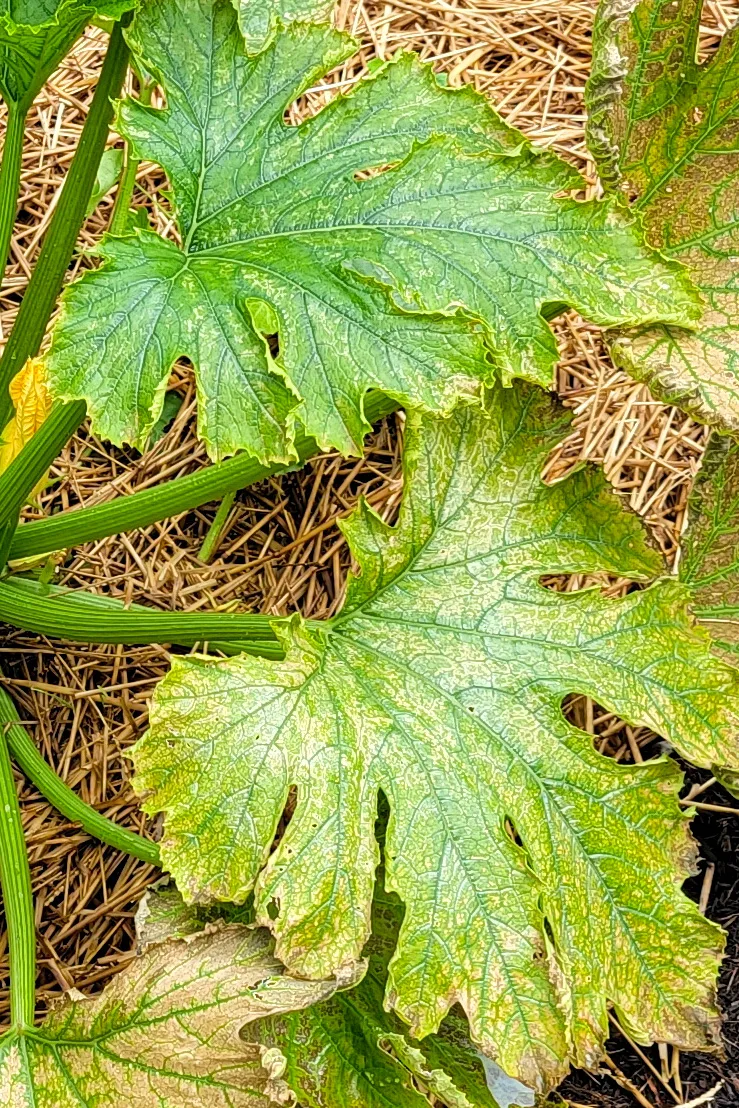
Powdery Mildew
Small yellow spots on leaves can be the start of powdery mildew. Yes, you may notice small yellow patches on the leaves before it takes on the characteristic white patches. If you catch it early, in this stage, it’s easier to deal with.
Downy Mildew
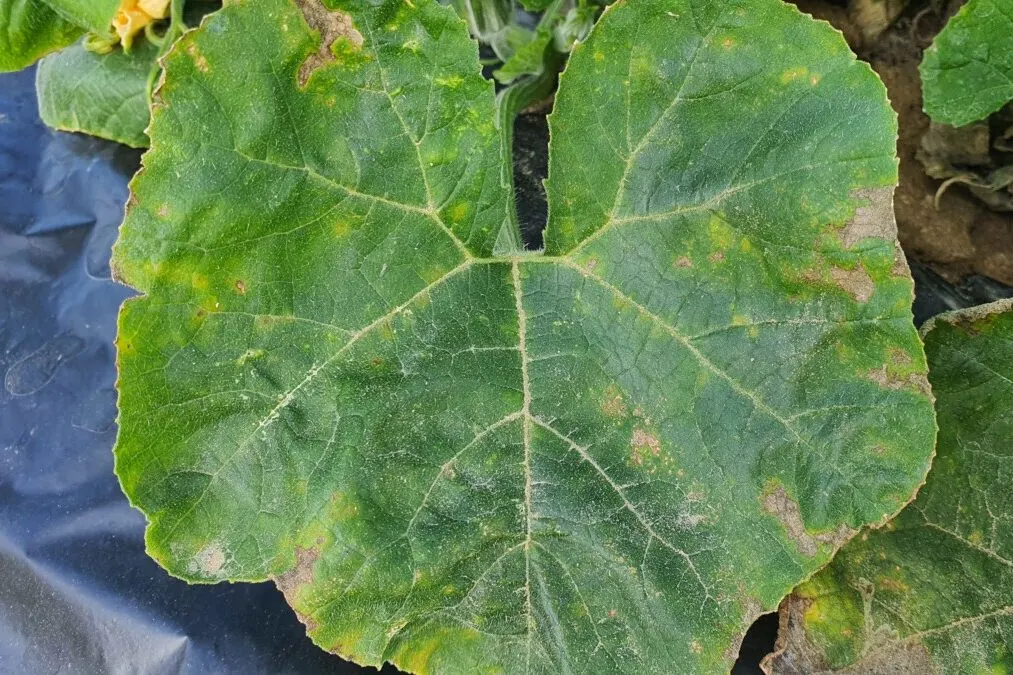
If you notice light yellow, brown or tan spots on the leaves that are angular, chances are good it’s downy mildew, a type of mold, P. cubensis. If you flip the leaves over, you’ll likely find spores growing on the undersides of these spots.
Downy mildew shows up during cool, rainy seasons starting in June and continuing through the summer. It can affect more than your zucchini. Squash, pumpkins, cucumbers, melon, and even spinach are all vulnerable. It’s more common in the warmer southern states but can spread northward as the season progresses.
If you suspect that your zucchini has downy mildew, check out the Cucurbit Downy Mildew Forecast map, where you can see outbreaks and sign up to be notified of new outbreaks.
Downy mildew can be controlled with a copper-based fungicide. Again, crop rotation can help in subsequent years.
Nutrient Deficiency
A lack of iron or magnesium can lead to interveinal necrosis, which looks like yellowing between the veins on the leaf. Read Lindsay’s article and have your soil tested if you suspect a nutrient deficiency.
4. Yellowish or Pale Green Leaves
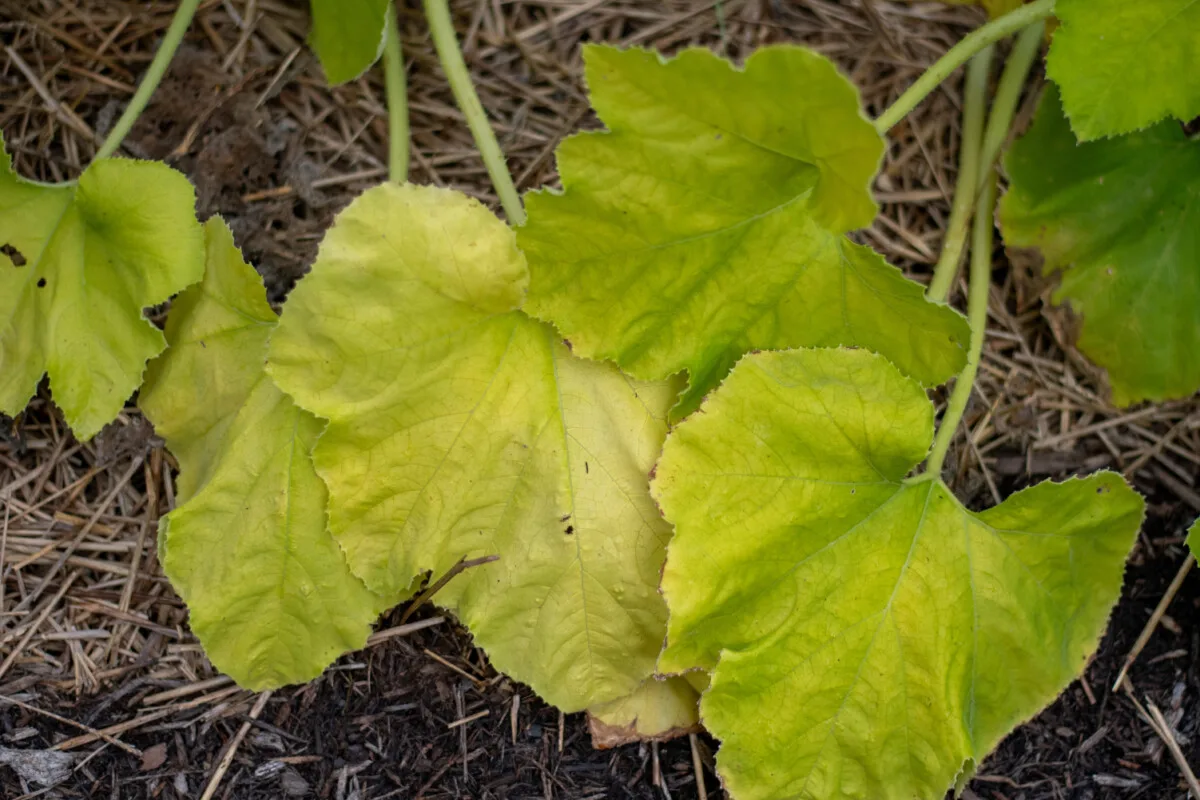
Water Issues
Like wilting leaves, yellowing leaves can be the product of the same watering issues noted above. You’ll want to reference those again to help diagnose your particular issues. Typically, it’s become more advanced if you notice yellow leaves, and it’s a water issue. You’ll need to take action to remedy the situation and allow the plant to bounce back.
Pests
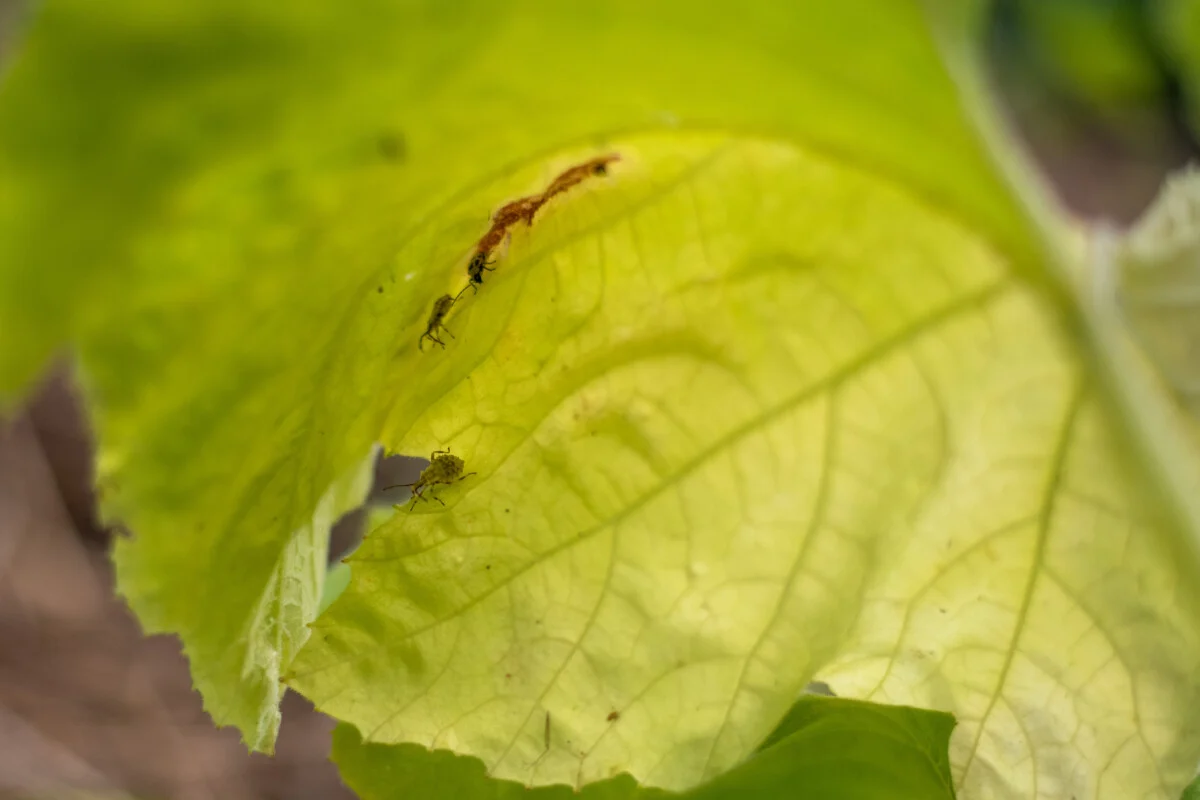
One of the easiest ways to tell if you have something nibbling on your zucchini is if the leaves grow paler by the day. Most common zucchini and summer squash pests feast on the plant’s sap, weakening it and causing the leaves to discolor. Squash bugs, aphids, spider mites and whiteflies are common squash pests that can damage leaves.
You can spray the plant with insecticidal soap or neem oil to stop pests. Remember to spray early in the morning when flowers are still closed, and pollinator activity is low. You might also want to try encouraging predatory insects to take up residence in your garden.
Frost Damage
Summer squash are not frost-hardy; even a light frost can cause damage, including yellow leaves. Learn how to protect your zucchini from the cold and extend your growing season.
Nutrient Deficiency
Yellow leaves can be a sign of a lack of nitrogen. Check nearby plants for similar issues; this will help to clue you in on whether something else may be going on. Nutrient deficiencies are much less common than environmental stressors, pests or diseases.
5. Brown Curling Leaves
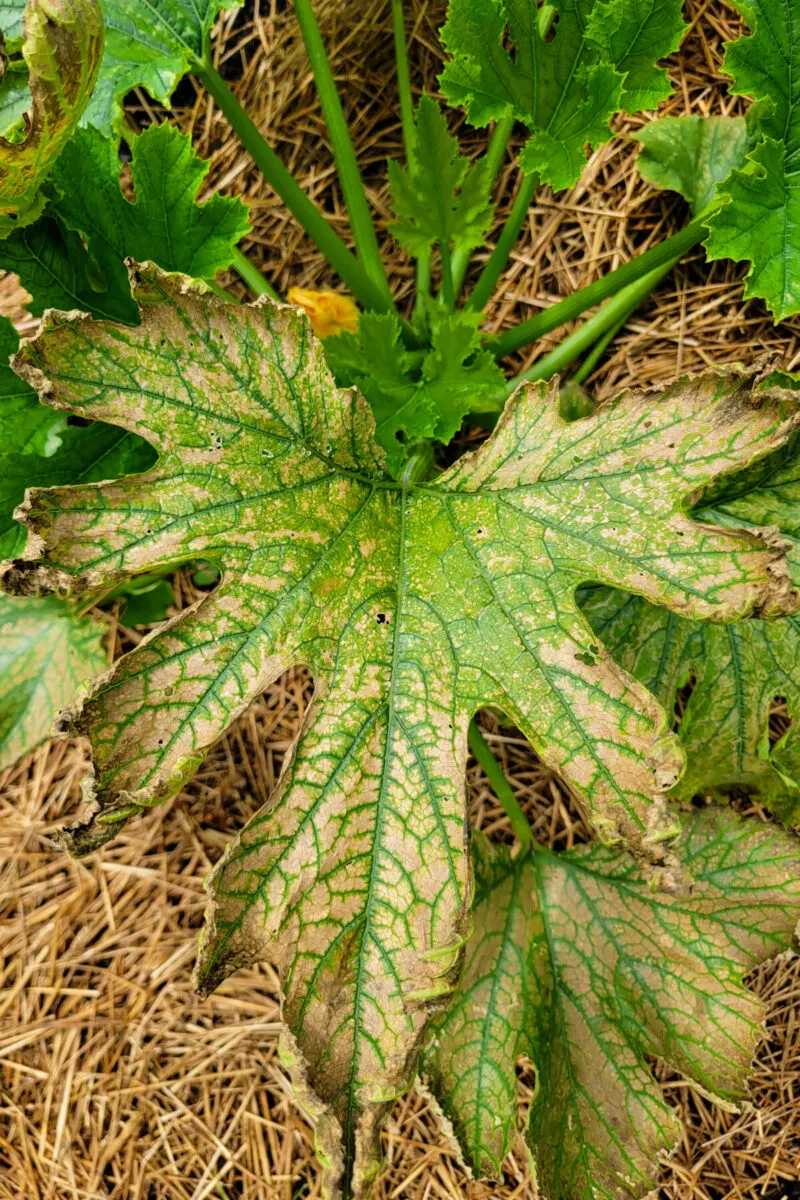
Severe Drought
During severe drought and high heat, the leaves on your zucchini plant can brown and curl rapidly. When watering your plants, be sure to water them deeply, letting water soak deep into the ground, especially during lengthy periods without rain.
By providing adequate water during extreme temperatures, the plant should bounce back.
Advanced Pest Damage or Disease
Unfortunately, if it’s not an environmental stressor, and your zucchini has brown curling leaves, there were likely other changes to the leaves that went unnoticed until now. Brown curling leaves are usually an advanced stage of pest damage or disease.
At this point, it’s best to remove the damaged leaves and look for clues on less damaged leaves or the stem or fruit of the plant to determine what’s attacking the plant.
An Ounce of Prevention
We usually notice something’s not quite right when the leaves of our zucchini start looking a bit off. Maybe they’re a tad too yellow; maybe they’re curling or have odd patches. But by the time we notice issues with the leaves, it’s safe to assume whatever pest, disease or environmental stressor is the cause has been at it for a while.
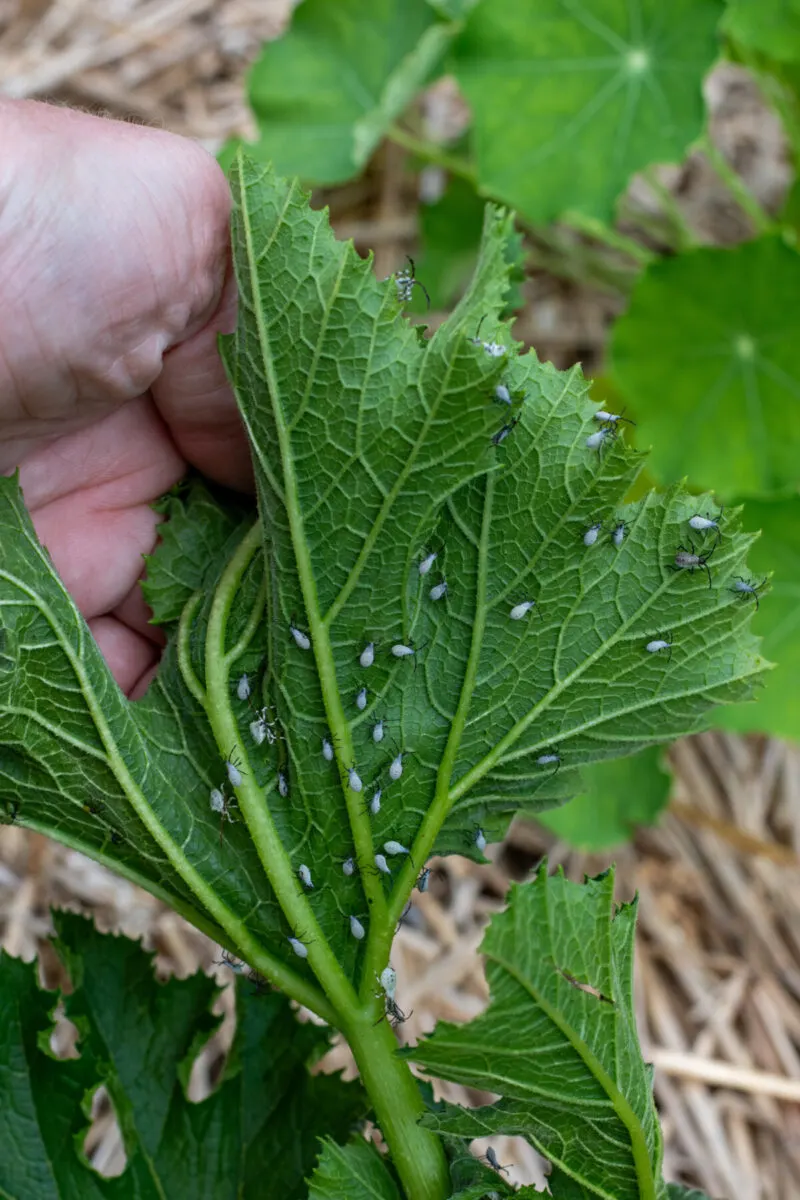
It’s always a good idea to check your plants when tending your garden. Look at the stems and turn leaves over, looking closely at the plant’s interior. This is the best way to spot issues before they get out of hand. Many pests can easily be dealt with by hand picking them off before they multiply and become a problem.
As you monitor the plant’s overall health, you’re more likely to catch something and remedy it before it gets out of hand.

Get the famous Rural Sprout newsletter delivered to your inbox.
Including Sunday musings from our editor, Tracey, as well as “What’s Up Wednesday” our roundup of what’s in season and new article updates and alerts.

